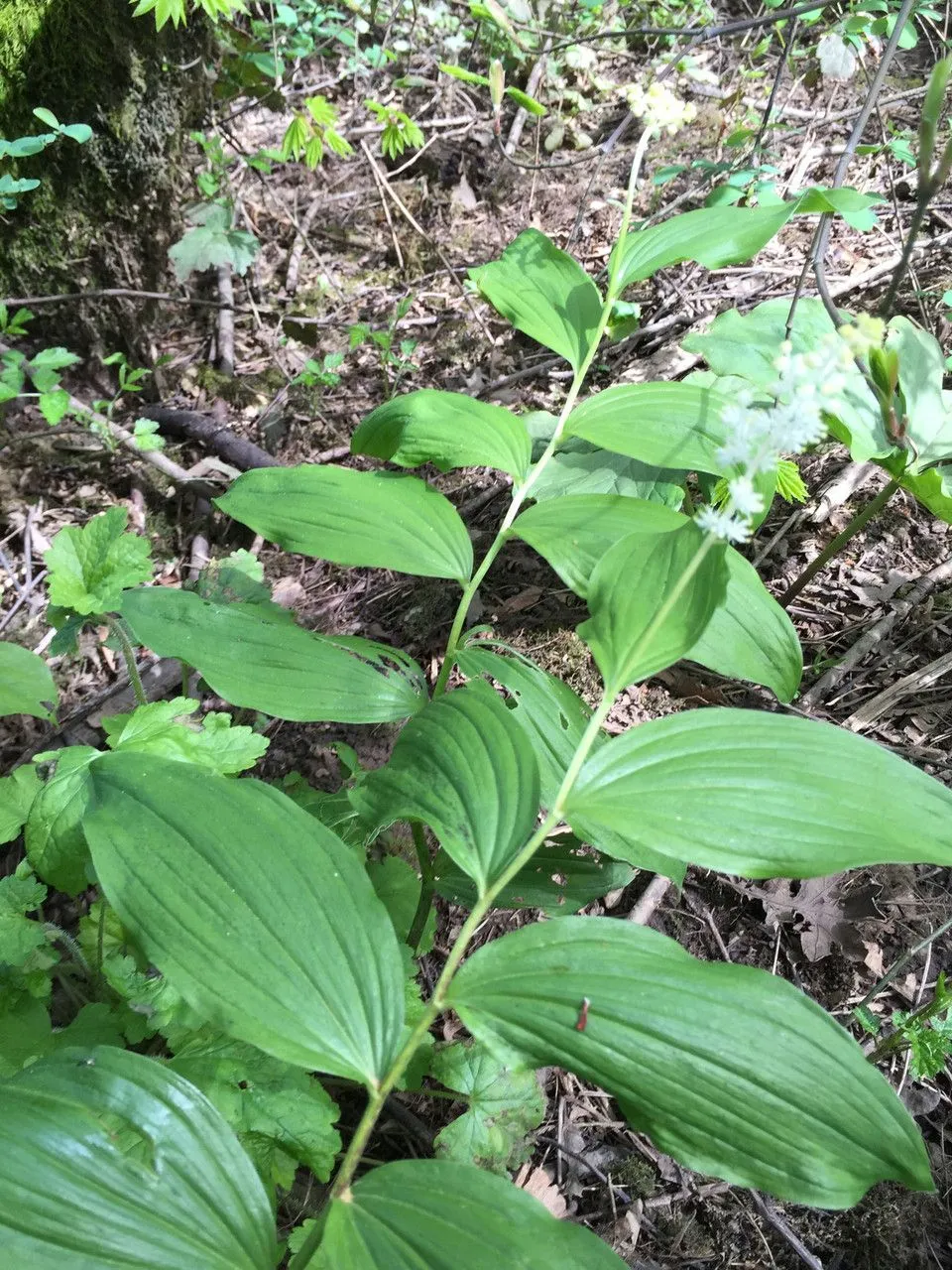
Author: (L.) Link
Bibliography: Enum. Hort. Berol. Alt. 1: 343 (1821)
Year: 1821
Status: accepted
Rank: species
Genus: Maianthemum
Vegetable: False
Observations: N. America to Mexico (Chihuahua)
Solomon’s-plume, scientifically recognized as Maianthemum racemosum, is an exquisite perennial plant belonging to the Asparagaceae family. This enchanting species is intrinsically linked to regions ranging from North America to Mexico, particularly thriving in areas including Chihuahua.
Renowned for its graceful and arching stems, Solomon’s-plume is a sight to behold in the wild. The plant flourishes in wooded areas and along the edges of forests, where it benefits from partial shade and well-drained soils. One of its most distinctive features is the graceful, feather-like clusters of small, star-shaped, creamy white flowers that bloom in the late spring and early summer. These flowers are arranged in panicles that extend elegantly from the tops of the stems, almost giving the appearance of a feathered plume, which indeed pays homage to its common name.
Aside from its striking aesthetic appeal, the plant’s structure is noteworthy. The leaves are lance-shaped, dark green, and alternate along the stem. Each leaf measures between two to four inches long, coupled with a sheen that adds to the plant’s ornamental quality. The leaves are well-spaced, allowing both flowers and foliage to make a balanced visual impression.
As the flowering season draws to a close, the plant begins to form berries that start as green and mature into a bright red during the summer. These berries are not only visually attractive but also play a crucial role in the local ecosystem, providing food for various bird species.
Solomon’s-plume is more than just a pretty face in the plant kingdom; it has historical and cultural significance as well. Indigenous peoples in its native regions have historically used parts of the plant for various medicinal purposes, showcasing its usefulness beyond horticultural beauty.
Growing Solomon’s-plume in a garden setting requires mimicking its natural habitat. It prefers humus-rich, moist soils and thrives in the dappled light beneath taller plants or trees. With its elegant foliage and dramatic flower plumes, it makes a splendid addition to any shaded garden area, providing a touch of woodland charm and serene beauty.
In conclusion, Solomon’s-plume (Maianthemum racemosum) is a captivating and valuable member of the Asparagaceae family, admired not only for its visual appeal but also for its contribution to biodiversity and traditional medicine. This plant, documented as early as 1821 in the “Enum. Hort. Berol. Alt. 1: 343” by (L.) Link, continues to captivate nature enthusiasts and gardeners alike with its elegant presence and ecological relevance.
Eng: false solomon’s-seal, false spikenard, feathery false lily of the valley, feathery false lily of the vally, feathery false solomon’s seal, feathery false solomon’s-seal, large false solomon’s-seal, solomon’s-plume, treacle-berry, large false solomon’s seal, false solomon’s seal, feathery false lily-of-the-valley, plumed solomon’s seal, plumed spikenard, solomon’s plume
Dan: skyggeblomst
Swe: vipprams
Fra: smilacine à grappes, maïanthème à grappes
En: Solomon’s-plume, Large false Solomon’s-seal, Treacle-berry, False spikenard, Feathery false lily of the valley, False Solomon’s Seal, Feathery False Solomon’s-Seal, False Solomon’s-seal, Feathery Solomon plume, Feathery false Solomon’s seal, Feathery false lily of the vally, Large false Solomon’s seal, Solomon’s plume, Feathery false lily-of-the-valley, Plumed Solomon’s seal, Plumed spikenard
Cr: Kawawkanaht
Cs: Smilacina hroznovitá
Da: Almindelig Skyggeblomst, Skyggeblomst
Fi: Tertturotkokielo
Fr: Maïanthème à Grappes, Smilacine à grappes
De: Duftsiegel, Rispen-Duftsiegel, Traubige Schattenblume
Nv: Naadą́ą́ʼ yiltʼąąʼí
Sv: Vipprams
© copyright of the Board of Trustees of the Royal Botanic Gardens, Kew.
© copyright of the Board of Trustees of the Royal Botanic Gardens, Kew.
© copyright of the Board of Trustees of the Royal Botanic Gardens, Kew.
Taken Aug 12, 2021 by Cole O’Brien (cc-by-sa)
Taken Aug 15, 2021 by tmzante (cc-by-sa)
Taken May 19, 2019 by Bryce (cc-by-sa)
Taken Jul 5, 2015 by EOL − reynoldsj13 (cc-by-nc)
Taken Jun 19, 2017 by Bre McFarland (cc-by-sa)
Taken Jun 4, 2021 by shadow minto (cc-by-sa)
Taken May 28, 2022 by Nicole Nicole (cc-by-sa)
Taken Jun 2, 2022 by Sally Sutton (cc-by-sa)
Taken Jun 2, 2022 by jake kristophel (cc-by-sa)
Taken May 5, 2019 by Torres Cody (cc-by-sa)
Taken Apr 7, 2016 by EOL − Christian Haaning (cc-by-nc)
Taken Jul 26, 2017 by Brie Kapina (cc-by-sa)
Taken Jun 14, 2020 by Mike Elliott (cc-by-sa)
Taken May 13, 2022 by Kai Best (cc-by-sa)
Taken Jul 26, 2017 by Brie Kapina (cc-by-sa)
Taken Aug 18, 2021 by Victoria Zien (cc-by-sa)
Taken Aug 28, 2022 by Priscilla MV (cc-by-sa)
Taken Aug 15, 2021 by tmzante (cc-by-sa)
Taken Oct 3, 2022 by anne morrow (cc-by-sa)
Taken Aug 17, 2021 by Micha Ayotte (cc-by-sa)
Taken Jun 8, 2020 by Emma Emma Swendsen (cc-by-sa)
Taken May 18, 2022 by PT (cc-by-sa)
Taken Jun 3, 2022 by PT (cc-by-sa)
Taken Dec 1, 1998 by EOL − Charles Webber (cc-by-nc-sa)
Taken Dec 1, 1998 by EOL − Charles Webber (cc-by-nc-sa)
Taken Oct 16, 1998 by EOL − Charles Webber (cc-by-nc-sa)
Taken Oct 16, 1998 by EOL − Charles Webber (cc-by-nc-sa)
Taken Jun 9, 2019 by Xingyu Zhou (cc-by-sa)
Growth habit: Forb/herb
Family: Myrtaceae Author: (F.Muell.) K.D.Hill & L.A.S.Johnson Bibliography: Telopea 6: 402 (1995) Year: 1995 Status:…
Family: Rubiaceae Author: Pierre ex A.Froehner Bibliography: Notizbl. Bot. Gart. Berlin-Dahlem 1: 237 (1897) Year:…
Family: Sapindaceae Author: Koidz. Bibliography: J. Coll. Sci. Imp. Univ. Tokyo 32(1): 38 (1911) Year:…
Family: Asteraceae Author: A.Gray Bibliography: Pacif. Railr. Rep.: 107 (1857) Year: 1857 Status: accepted Rank:…
Family: Fabaceae Author: Medik. Bibliography: Vorles. Churpfälz. Phys.-Ökon. Ges. 2: 398 (1787) Year: 1787 Status:…
Family: Aspleniaceae Author: (Cav.) Alston Bibliography: Bull. Misc. Inform. Kew 1932: 309 (1932) Year: 1932…